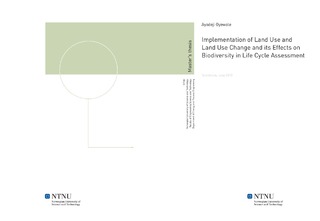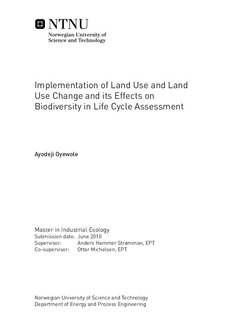| dc.description.abstract | Land use refers to the use of land for intensive human activities aiming at exclusive use of land for certain purposes and adapting the properties of land areas in view of these purposes. Environmental problems are, however, generated as a result of these human activities which modify the shape and properties of large land areas according to the requirements of human activities and thereby excluding wild animals and plants from coexisting on such land areas and in their neighbourhoods. Land use also leads to the degradation of the natural environment. Life Cycle Assessment (LCA) methodology is used for evaluating the environmental burdens associated with products or processes while taking their whole life cycle into consideration. LCA is a comprehensive assessment method which considers all aspects of natural environment, human health, and resources. Land use is regarded as an impact category in Life Cycle Assessment and is treated as such. However, the environmental impacts associated with land use and land use change are not being adequately considered in LCA, if considered at all.Life Cycle Impact Assessment is a part of LCA and is aimed at understanding and evaluating the magnitude and significance of the potential environmental impacts of products or processes and this involves developing characterization factors which link an environmental impact to a category indicator. In the assessment of land use impacts, characterization factors are developed so as to weigh the magnitude of environmental interventions such as land occupation and land transformation on the potentially affected attributes of ecosystem quality such as biodiversity, ecological functions and natural resources.The goal of this study is to review the progress of the implementation of land use and land use change as an impact category in LCA with a particular focus on biodiversity, recognize limitations, and indicate future prospects for the development of land use impact assessment methodologies and subsequent integration into LCA. Land use impacts are not being widely integrated into LCA because they are dependent on the regional or local situation which is not well known in LCA and land use as an environmental intervention is very complex. However, the importance of land use cannot be overemphasized when assessing products or processes which make use of raw materials that originate from land extensive activities. Despite this importance, there have been diverse arguments on how to include land use impacts, for example, on biodiversity in LCA so as to provide a common and acceptable methodology for this assessment.This study focuses on how land use impacts can be included in LCA. With a particular focus on land use impacts on biodiversity, the result of this review shows that only a few studies have been carried out. The problem of non-convergence of the methodology for the assessment of land use in LCA still persists because most of the proposed methodologies deal with different aspects of land use impacts and are therefore conflicting.Most of the studies reviewed stress the importance of biodiversity measured in terms of vascular plant species diversity. However, there are other methodologies which consider other impact pathways such as life support functions. The number of studies thereby correlates with an increase in the interest in the research area. However, it is difficult to identify any trend of convergence. Different methods are being proposed which do not actually agree with one another. Some of these methods are not closely related to the use of land in the normal usage sense. Most of the methods being proposed are exemplified in different regions and these have not been found to be applicable to global cases. This could be a limiting factor for the applicability of the proposed methodologies in LCA. In order to overcome these shortcomings, more research work would be needed before these methodologies could be incorporated into LCA which is presumed to be a global assessment methodology. This will enhance the credibility of the results provided by an LCA and the subsequent acceptability of the LCA methodology. | nb_NO |

